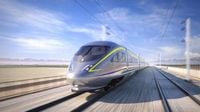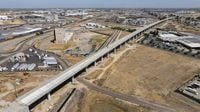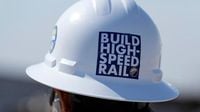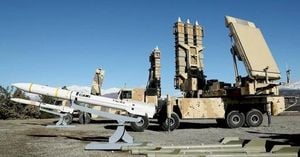California’s high-speed rail project, once hailed as the golden ticket to revolutionizing public transit on the West Coast, has hit yet another fork in the road. On August 25, 2025, state lawmakers and business leaders gathered in Sacramento to deliver much-anticipated updates on the embattled project, which has been both a symbol of futuristic ambition and a magnet for controversy since voters approved its funding back in 2008.
Back then, hopes were high: a sleek, electric train would zip passengers from Los Angeles to San Francisco via the Central Valley, all for an initial price tag of $33 billion, with trains expected to be rolling by 2020. Fast forward to today, and that optimism has been replaced by a sobering reality check. According to the latest estimates, the project’s cost could soar to a staggering $128 billion, and the finish line has been pushed back nearly two decades, with completion now eyed for 2038. That’s not just sticker shock—it’s a seismic shift in expectations, as reported by KABC and KBAK/KBFX.
The only visible progress so far? Construction crews busy at work in the Central Valley, laying the foundation for what many still hope will become America’s first true high-speed rail corridor. Yet, much of the envisioned route—especially the critical link from Palmdale to Gilroy, just south of San Jose—remains little more than lines on a map. That particular segment alone is expected to gobble up $87 billion and, if all goes according to plan, won’t be ready until 2038.
At Monday’s news conference, state transportation leaders made their case for pushing forward, unveiling a new legislative push: Senate Bill 545. The bill aims to secure fresh funding sources and, as its proponents argue, unlock a wave of residential and commercial development along the future rail corridor. Senator Dave Cortese, who chairs the Senate Transportation Committee and authored the bill, didn’t mince words about what’s at stake. “We’re here today because high-speed rail is California’s opportunity to lead the nation in clean, fast, and safe public transit. That’s number one,” he said, according to KBAK/KBFX.
Cortese also pointed to the project’s broader benefits—economic growth and pollution reduction among them. “This is how we grow our economy and cut pollution at the same time,” he told reporters. He emphasized that public opinion, especially among younger generations, remains in the project’s corner. “A majority of voters continue to support this project,” Cortese declared. “We know that—with support even higher among younger generations who see this as part of their future. Why wouldn’t they?”
But not everyone is convinced. The project’s ballooning costs and repeated delays have drawn sharp criticism at the federal level. Just last month, the Trump administration announced it would pull $4 billion in federal funding, a blow that sent shockwaves through the project’s leadership. President Donald Trump and Transportation Secretary Sean Duffy have been especially vocal, deriding the rail as a “train to nowhere.” In response, the California High-Speed Rail Authority quickly filed a lawsuit to try to restore the lost funds, though the legal battle is far from resolved.
Even as political wrangling continues, the nuts and bolts of the project are being re-examined. The California High-Speed Rail Authority recently released a comprehensive update, laying out several scenarios for moving forward. One proposal would limit the rail’s reach to a corridor between Merced and Bakersfield—a scaled-back option that the Authority itself admits would not be profitable in the long term. Other alternatives include routes from Gilroy to Bakersfield or Gilroy to Palmdale, but each comes with its own set of financial and logistical hurdles.
Governor Gavin Newsom has thrown his support behind the project, proposing $1 billion in annual state funding. But even with that commitment, officials acknowledge that public money alone won’t be enough. “As much as we need public participation and continued commitment from California, we need private investment in this project, and we will have that as well,” a spokesperson insisted during the press event, as reported by KBAK/KBFX. The hope is that a combination of state backing and private capital will close the funding gap, though attracting investors to a project with such a troubled history is no small feat.
Despite the daunting numbers and political headwinds, Senator Cortese remains adamant that the project’s finances have been handled with integrity. “The voters, um, approved in terms of where these dollars go without fraud, without defalcation, without diversion of these dollars to any other project, that’s all happened. That promise has been kept. There’s no need to go back to the voters,” he assured, addressing concerns about transparency and accountability.
Yet, the project’s critics aren’t easily swayed. Detractors argue that the high-speed rail has become a cautionary tale of government overreach and mismanagement. The “train to nowhere” label has stuck in some circles, and opponents question whether the state should keep pouring billions into a project that seems perpetually just out of reach. Supporters, meanwhile, counter that abandoning the project now would squander not only the money already spent but also the potential to transform California’s transportation landscape and meet ambitious climate goals.
It’s not all doom and gloom, though. Advocates point to the transformative impact the rail could have on communities along its route. By fostering new development and providing a fast, clean alternative to car and air travel, the project could help ease congestion, boost local economies, and make a real dent in the state’s carbon emissions. Senator Cortese and his allies argue that these long-term benefits far outweigh the near-term headaches.
The road ahead is anything but certain. With legal battles brewing, funding questions unresolved, and construction limited to a single stretch in the Central Valley, the California high-speed rail project faces its toughest test yet. But for those who still believe in the vision of a truly modern, sustainable transportation system, the dream is very much alive—albeit a bit delayed and a lot more expensive.
As the debate rages on, one thing is clear: California’s high-speed rail saga is far from over. Whether it ultimately delivers on its promise or becomes a cautionary tale for future infrastructure projects remains to be seen. For now, all eyes are on Sacramento as lawmakers, business leaders, and citizens alike wait to see if this train will ever leave the station.






